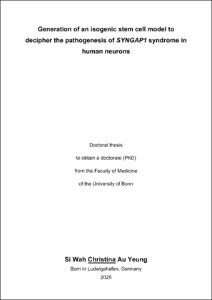Generation of an isogenic stem cell model to decipher the pathogenesis of SYNGAP1 syndrome in human neurons
Generation of an isogenic stem cell model to decipher the pathogenesis of SYNGAP1 syndrome in human neurons
| dc.contributor.advisor | Brüstle, Oliver | |
| dc.contributor.author | Au Yeung, Si Wah Christina | |
| dc.date.accessioned | 2025-04-03T14:12:50Z | |
| dc.date.available | 2025-04-03T14:12:50Z | |
| dc.date.issued | 03.04.2025 | |
| dc.identifier.uri | https://hdl.handle.net/20.500.11811/12983 | |
| dc.description.abstract | The synaptic GTPase-activating protein SynGAP is an important constituent of the postsynaptic compartment. Haploinsufficiency of the SYNGAP1 gene is associated with a neurodevelopmental disorder characterized by mental retardation, moderate to severe intellectual disability, global developmental delay, and a generalized form of epilepsy. Most of the studies on SYNGAP1 syndrome were performed in Syngap1 +/- and -/- mouse models. Although animal-based experiments have made significant contributions to understanding disease mechanisms, these models are limited when it comes to human conditions, primarily due to major disparities in physiology and development. Here, we set out to model this disorder using isogenic engineered SYNGAP1 haploinsufficient human pluripotent stem cells and forward programmed them into neurons for disease modeling. SYNGAP1 +/- glutamatergic neurons (iGlutNs) showed increased Ras-GTP and phospho-Erk concentration, alterations in pathways downstream of SynGAP. These pathway alterations may contribute to increased neural complexity, as evidenced by the longer and more intricate dendritic structures observed in our model. At the synaptic level, we noted a general increase in spine surface area and length. Moreover, there was a rise in the proportion of mature, mushroom-shaped spines, suggesting enhanced differentiation. Electrophysiologically, at the network level, the SYNGAP1 +/- neurons showed a higher network burst frequency with concurrently shorter network bursts and fewer spikes per network burst, with overall lower synchrony. Additionally, SYNGAP1 +/- neurons demonstrated elevated expression of AMPA receptors, potentially leading to postsynaptic saturation. This saturation could result in the occlusion of long-term potentiation (LTP), a phenomenon that was confirmed through patch-clamp experiments. The increased network burst frequency and duration might be a phenotype originating from glutamatergic neurons, while the decreased number of spikes might evolve from GABAergic neurons, suggesting that SYNGAP1 also plays a role in inhibitory neurons. The pathoelectrophysiological network pattern might resemble the phenotypes to those found in primary neurons from mouse epilepsy models. Overall, these findings indicate that SynGAP, through alterations in RasGTP and Erk concentration may promote spine growth and synaptic strength through multiple pathways, including actin polymerization and AMPAR insertion. This ultimately may lead to impaired LTP resulting in altered neuronal activity. | en |
| dc.language.iso | eng | |
| dc.rights | In Copyright | |
| dc.rights.uri | http://rightsstatements.org/vocab/InC/1.0/ | |
| dc.subject.ddc | 570 Biowissenschaften, Biologie | |
| dc.subject.ddc | 610 Medizin, Gesundheit | |
| dc.title | Generation of an isogenic stem cell model to decipher the pathogenesis of SYNGAP1 syndrome in human neurons | |
| dc.type | Dissertation oder Habilitation | |
| dc.identifier.doi | https://doi.org/10.48565/bonndoc-542 | |
| dc.publisher.name | Universitäts- und Landesbibliothek Bonn | |
| dc.publisher.location | Bonn | |
| dc.rights.accessRights | embargoedAccess | |
| dc.date.embargoEndDate | 01.05.2026 | |
| dc.identifier.urn | https://nbn-resolving.org/urn:nbn:de:hbz:5-82212 | |
| ulbbn.pubtype | Erstveröffentlichung | |
| ulbbnediss.affiliation.name | Rheinische Friedrich-Wilhelms-Universität Bonn | |
| ulbbnediss.affiliation.location | Bonn | |
| ulbbnediss.thesis.level | Dissertation | |
| ulbbnediss.dissID | 8221 | |
| ulbbnediss.date.accepted | 31.03.2025 | |
| ulbbnediss.institute | Medizinische Fakultät / Institute : Institut für Rekonstruktive Neurobiologie (IRN) | |
| ulbbnediss.fakultaet | Medizinische Fakultät | |
| dc.contributor.coReferee | Schmucker, Dietmar | |
| ulbbnediss.date.embargoEndDate | 01.05.2026 |
Files in this item

This document has got an embargo.
This item appears in the following Collection(s)
-
E-Dissertationen (1997)



